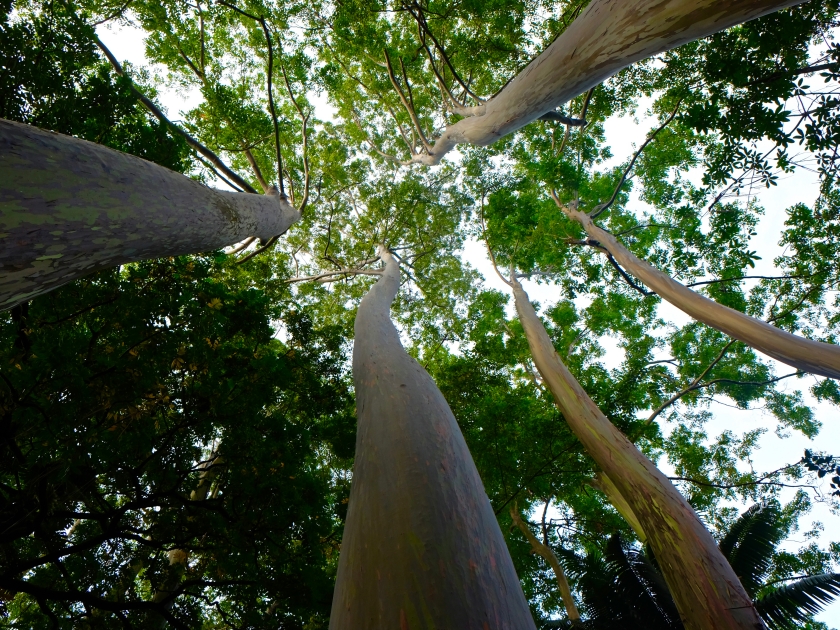Tucked away along the picturesque Hana Highway in Maui, Keanae Arboretum offers a serene escape for nature enthusiasts and travelers looking for a tranquil retreat. Spanning six acres, this botanical haven features over 150 species of tropical plants, making it a must-visit destination for those exploring Maui’s verdant beauty. In this guide, we’ll delve into the top attractions of Keanae Arboretum, activities to enjoy, essential travel tips, and more.
Highlights
- The arboretum is famous for its vibrant rainbow eucalyptus trees, known for their striking multicolored bark that peels away to reveal stunning hues of orange, red, and green.
- With around 150 different tropical plant species, including native Hawaiian flora and important canoe plants like breadfruit and taro, the arboretum offers a unique insight into Hawaii’s rich botanical heritage.
- Each plant is labeled with its common and scientific names, as well as its country of origin, making it an educational stop for families and plant enthusiasts alike.
- The main path is a well-maintained 0.6-mile paved walkway that winds through the arboretum’s diverse landscape, providing a serene environment for strolls amidst nature.
- The arboretum is situated on terraces historically used by Native Hawaiians for taro cultivation, offering visitors a glimpse into the agricultural practices of ancient Hawaiian culture.
- Along the Pi’ina’au Stream, visitors can find natural pools perfect for wading or soaking on warm days. It’s advisable to check water clarity before entering.
History

Establishment Date
Keʻanae Arboretum was established in 1971, marking its transition into a dedicated space for the conservation and display of tropical plant species.
Historical Use of Land
Before the 1940s, the land where the arboretum is located was utilized for farming various plants, including food, medicinal, and fiber-producing species. From 1946 to the mid-1950s, it served as an agricultural work site for prisoners at Keʻanae Prison Camp. This historical context highlights the land’s agricultural significance prior to its designation as an arboretum.
Ancient Agricultural Innovation
Nestled along Maui’s iconic Hana Highway, Keʻanae Arboretum is situated on terraces built centuries ago by Native Hawaiians for taro cultivation. These leveled platforms showcase the ingenuity of ancient agricultural practices and emphasize the importance of taro as a staple crop deeply rooted in Hawaiian culture.
A Living Botanical Exhibit
As a vibrant botanical garden, Keʻanae Arboretum features over 150 tropical plant species from around the globe. Each plant is thoughtfully labeled with its common and scientific names, as well as its origin, creating an educational experience that highlights the ecological and cultural significance of these species. Visitors can explore a paved walking path that runs approximately 0.6 miles, making it accessible for a leisurely stroll through diverse flora, including notable species like rainbow eucalyptus, hibiscus, and various types of taro.
Preserving Traditional Lifestyles
The Keanae community is celebrated for maintaining sustainable agricultural practices that mirror those of their ancestors. Surrounding the arboretum, locals continue to cultivate crops like taro, bananas, and yams, fostering a deep connection to the land and its traditions.
Restoring Environmental Balance
Recent restoration efforts focus on reviving stream flows that sustain Keanae’s agricultural systems, reflecting the ongoing environmental challenges faced by the community. The arboretum stands as a tranquil space where visitors can explore the harmonious relationship between Hawaiian heritage and the natural world.
Things to Do
Stroll Through the Tropical Gardens
Take a relaxing walk along the paved trail that meanders through the arboretum, offering an immersive experience in Maui’s vibrant tropical flora. This easy path, suitable for all ages, invites visitors to unwind while admiring the diverse collection of plant species thriving in this lush, tranquil setting.
Capture Picture-Perfect Moments
Bring your camera or smartphone to capture the arboretum’s incredible beauty. From the vivid hues of the iconic rainbow eucalyptus trees to the intricate details of exotic flowers, this botanical sanctuary is a dream for photography enthusiasts. Whether you’re focusing on the vibrant foliage or unique textures, you’ll find endless opportunities for stunning snapshots.
Discover Historic Taro Fields
Head toward the upper reaches of the arboretum to explore traditional taro fields (lo‘i), a window into the ancient agricultural practices of Native Hawaiians. While some fields may appear overgrown, they remain a testament to the island’s rich cultural heritage and the importance of taro in Hawaiian history.
Cool Off in Natural Pools
On warmer days, you may find natural pools along Pi‘ina‘au Stream inviting for a refreshing dip. These serene spots are perfect for relaxing, but always check water clarity and conditions before entering to ensure a safe experience.
Learn About Hawaii’s Native Plants
Enhance your visit by reading the educational plaques located throughout the arboretum. These signs provide fascinating details about the origins, cultural significance, and ecological roles of the various plant species, offering a deeper appreciation for Hawaii’s unique environment.
Reconnect with Nature
Find a peaceful corner by the stream or beneath the shade of a tree to relax and soak in the calming atmosphere. Use this moment to meditate, practice mindfulness, or simply enjoy the serene sounds of nature. The tranquil setting of Keanae Arboretum is perfect for escaping the hustle of daily life and fostering a deeper connection with the natural world.
Practical Information
Keanae Arboretum is conveniently located approximately 0.8 miles past mile marker 16 on the Hana Highway. While there is a paved parking area for visitors, the site lacks facilities like restrooms or food services, so it’s essential to come prepared with any supplies you may need.
Tips for Visiting
- Bring Bug Spray: Mosquitoes are common, so applying insect repellent will ensure a more comfortable visit.
- Wear Comfortable Shoes: While the path is mostly paved, some areas can be uneven. Sturdy footwear is recommended.
- Check Water Conditions: If you plan to enjoy the natural pools, always ensure the water is safe for swimming.
- Respect Nature: Avoid picking plants or flowers; instead, admire them in their natural surroundings.
- Plan Your Visit: Allocate at least an hour to explore the arboretum fully and enjoy its beauty.
- Stay Hydrated: Carry water, especially if you plan to spend time walking or exploring.
- Visit Early or Late: For a quieter experience and cooler temperatures, visit in the early morning or late afternoon.
Best Time to Visit
The ideal time to visit Keanae Arboretum is during the dry season, from April to October when there’s less rainfall. Early mornings and late afternoons are perfect for enjoying cooler weather and avoiding crowds while exploring this tropical haven.
Nearby Attractions

Enhance your visit to Keanae Arboretum by exploring nearby attractions such as Waiʻānapanapa State Park, renowned for its striking black sand beach, freshwater caves, and scenic coastal trails, or take a short detour to Keanae Peninsula, where you can enjoy dramatic ocean views, historic taro fields, and a glimpse into traditional Hawaiian culture.
Frequently Asked Questions (FAQs)
No, entry to Keanae Arboretum is free for all visitors.
Plan to spend at least 30 minutes to an hour exploring the gardens.
There are no facilities such as restrooms or food services at the arboretum.
Swimming is possible if water conditions are clear; always prioritize safety first.
Expect to see over 150 varieties of tropical plants including rainbow eucalyptus, taro, and various fruit trees.
Yes! The paved path makes it accessible for families with children and strollers.
How to Get There
By Car
If you’re driving, take the Hana Highway (Highway 360) heading east from Kahului. The Keanae Arboretum is located about halfway to Hana, at mile marker 16. Look for the small parking area and signage on the left side of the highway. The drive is filled with lush vegetation and beautiful landscapes, so take your time to enjoy the surroundings. Be cautious of narrow roads and sharp turns along the highway.
By Bus
Public transportation to Keanae Arboretum can be challenging, as buses may not directly reach the site. You can take the Maui Bus from Kahului toward Hana, but note that service may be limited and may not stop directly at the arboretum. It’s recommended to check with Maui Bus services for the latest schedules and routes. Alternatively, consider combining a bus ride with a local tour service or rideshare for easier access.
Snap & Stroll
Keanae Arboretum is a hidden gem on Maui, offering a serene escape into nature with its diverse tropical flora and rich cultural significance. By practicing eco-conscious exploration, visitors can help preserve this natural sanctuary for future generations. We’d love to hear about your experience—feel free to share your stories and photos to inspire others to visit this tropical haven.




